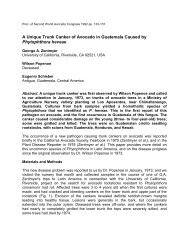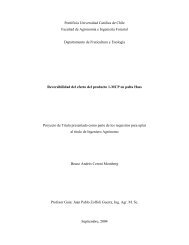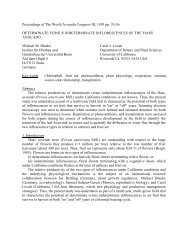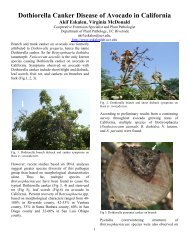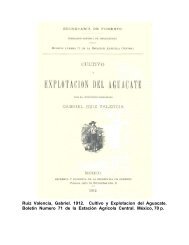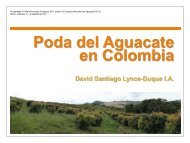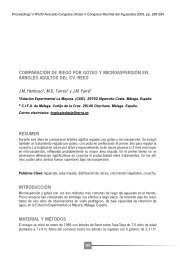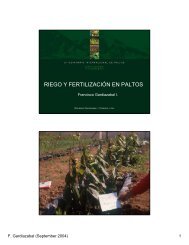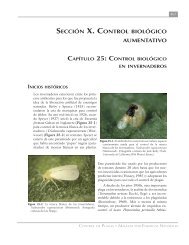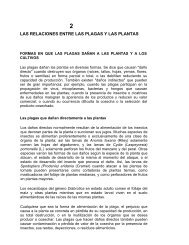An Investigation into Thinning of an Avocado Orchard
An Investigation into Thinning of an Avocado Orchard
An Investigation into Thinning of an Avocado Orchard
You also want an ePaper? Increase the reach of your titles
YUMPU automatically turns print PDFs into web optimized ePapers that Google loves.
South Afric<strong>an</strong> <strong>Avocado</strong> Growers’ Association Research Report for 1979. 3:59-60<br />
AN INVESTIGATION INTO THINNING OF AN AVOCADO ORCHARD<br />
JC TOERIEN & AM BASSON<br />
WESTFALIA ESTATE<br />
Progress Report<br />
OPSOMMING<br />
Produksie k<strong>an</strong> tydelik gestimuleer word deur ho<strong>of</strong> raamtakke laag te ringeleer in die jaar<br />
voordat borne uitgedun word. Borne moet egter gesond wees en 'n dunner ring word<br />
voorgestel a<strong>an</strong>gesien borne maklik doodga<strong>an</strong> as gevolg v<strong>an</strong> ringelering. Die<br />
wortelstelsel v<strong>an</strong> die boom wat gedun word, moet doodgemaak word om wortel<br />
kompetisie u it te skakel. Snoei v<strong>an</strong> avokadobome onderdruk die oes bale en word nie<br />
a<strong>an</strong>beveel nie.<br />
SUMMARY<br />
Trees c<strong>an</strong> be temporarily stimulated by ringbarking <strong>of</strong> main br<strong>an</strong>ches to increase<br />
production one year before trees are removed provided that trees are healthy, but a<br />
smaller ring is suggested to avoid prematurely killing the trees. The thinned tree's root<br />
system should be killed to prevent root competition. Pruning <strong>of</strong> avocado trees<br />
depresses the yield <strong>an</strong>d is not recommended.<br />
INTRODUCTION<br />
<strong>Thinning</strong> <strong>of</strong> avocado orchards is a subject on which considerable research has been<br />
done overseas, but there are m<strong>an</strong>y variations in the South Afric<strong>an</strong> avocado industry <strong>an</strong>d<br />
much more research is needed.<br />
PROCEDURE<br />
<strong>An</strong> Edr<strong>an</strong>ol orchard pl<strong>an</strong>ted in 1971 was due for thinning in 1978 with 90% <strong>of</strong> the<br />
orchard floor shaded out. The orchard was pl<strong>an</strong>ted 6m x 6m on the square having 277<br />
trees/ha. <strong>an</strong>d the trees were healthy. Ring barking <strong>an</strong>d thinning were done after<br />
harvesting (13,815 kg/ha.) on 1978.05.23.<br />
3 Rows <strong>of</strong> trees consisting <strong>of</strong> <strong>an</strong> average <strong>of</strong> 52 trees per plot were used <strong>an</strong>d only the<br />
centre row was used for data trees to determine effect on yield.
Treatments<br />
a). Alternate diagonal rows were ring barked above the bud union but low on the main<br />
br<strong>an</strong>ches with a 9 cm wide ring (Low Ring bark).<br />
b). Alternate diagonal rows were ring barked high, VB from the top at 5 m high on all<br />
br<strong>an</strong>ches with a 9 cm wide ring (High ring bark).<br />
c). Tip pruning <strong>of</strong> br<strong>an</strong>ches Vs from the top on alternate disposal rows % from the top at<br />
5 m (Top pruning).<br />
d). Alternate diagonal rows were cut low to the main br<strong>an</strong>ches <strong>an</strong>d protected against<br />
sunburn to keep root system alive <strong>an</strong>d maintain root competition (Stag horn).<br />
e). Alternate diagonal rows cut down <strong>an</strong>d killed with Roundup (Ground level).<br />
f). Alternate diagonal rows cut down <strong>an</strong>d root system removed by deep ripping<br />
(Removal).<br />
g). Crowded area as control (Crowded control).<br />
RESULTS<br />
DISCUSSION AND CONCLUSIONS<br />
a). Ring barking low on the main br<strong>an</strong>ches increased production by 37,8%. Although the<br />
ring barking was severe <strong>an</strong>d could harm the trees, it was done on those trees that<br />
had to be removed. In this way more production could be achieved on the<br />
temporary trees.<br />
b). Ring barking high on the br<strong>an</strong>ches resulted in lower production <strong>an</strong>d c<strong>an</strong> not be<br />
recommended.<br />
c). Pruning <strong>of</strong> the top Va <strong>of</strong> the tree reduced production by 83% <strong>an</strong>d is not<br />
recommended.<br />
d). Cutting the tree at ground level <strong>an</strong>d killing the root system seems to be the best way
<strong>of</strong> thinning but was only slightly better th<strong>an</strong> physical removal <strong>of</strong> the root system.<br />
Keeping the root system alive <strong>an</strong>d in competition with the root system <strong>of</strong> the<br />
perm<strong>an</strong>ent tree resulted in a 21,5% smaller crop th<strong>an</strong> the chemical killing <strong>of</strong> the root<br />
system.<br />
e). The 50% increase in production per tree with the removal <strong>of</strong> jot <strong>an</strong>d light competition<br />
over the crowded trees confirmed the import<strong>an</strong>ce <strong>of</strong> timely orchard thinning.<br />
REFERENCES<br />
TOERIEN, JC. 1977. Ondersoek om Produksie in Avokadoboorde wat verdig het te<br />
verhoog deur snoei en uitdunning. SAAGA H<strong>an</strong>delinge v<strong>an</strong> die Tegniese Komitee,<br />
p.41.



